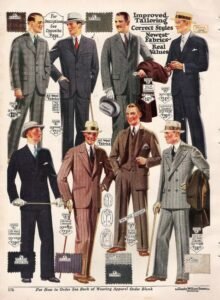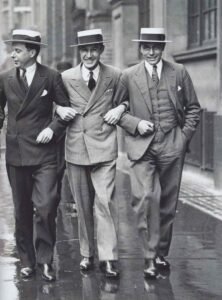The 1920s, often referred to as the Roaring Twenties, was a decade marked by profound cultural and social change. This era was characterized by economic prosperity, technological advancements, and a vibrant, shifting social landscape. Men’s fashion in the 1920s mirrored these transformations, embracing new styles and breaking away from the more conservative sartorial norms of previous decades. This period saw the emergence of distinctive trends in men’s clothing that were influenced by both the exuberance of the Jazz Age and the practicality demanded by changing lifestyles.
The Context of Change
To understand 1920s men fashion, it’s important to consider the historical context. The end of World War I in 1918 marked the beginning of a new era. The war had a significant impact on fashion, as military uniforms influenced civilian clothing. Additionally, the post-war period was marked by a desire for change and a break from tradition. The economy was booming, and this newfound wealth was reflected in the way people dressed.
The Rise of the Modern Suit
The suit was the cornerstone of men’s fashion in the 1920s. However, the suits of this decade were quite different from their predecessors. The most notable change was the silhouette. Suits became slimmer and more fitted, moving away from the boxy, loose styles of the early 1900s. The jackets were often shorter, with narrower lapels, and trousers were tailored to fit more closely to the leg.

One of the defining features of 1920s suits was the use of patterns and colors. Men began to experiment with bolder patterns such as checks, stripes, and plaids. The colors were also more varied, with shades of brown, gray, and blue becoming popular. This was a departure from the darker, more somber colors that had been the norm.
The Influence of Jazz and the Leisure Lifestyle
The 1920s was the Jazz Age, and the influence of this new music genre extended beyond the dance halls and into fashion. The leisure lifestyle that accompanied the popularity of jazz music meant that men needed more casual clothing options. This gave rise to the popularity of sportswear and more relaxed styles.
One of the most iconic casual styles of the 1920s was the plus-four trousers. These were a type of knickerbockers that extended four inches below the knee. They were often worn with argyle socks, and paired with a sweater or a sports jacket. This look was popular for golfing and other leisure activities.
The rise of the automobile also influenced men’s fashion. Driving required more practical clothing, and this led to the popularity of leather jackets and driving caps. These items not only provided the necessary protection but also became fashionable items in their own right.
Accessories and Finishing Touches
Accessories played a significant role in 1920s men’s fashion. Hats were a staple, with styles like the fedora, bowler, and flat cap being particularly popular. The fedora, with its wide brim and indented crown, became a symbol of the era. Men also wore bowler hats for more formal occasions and flat caps for casual wear.
Ties were another important accessory. The 1920s saw the emergence of the necktie as we know it today. Men wore ties in a variety of patterns and colors, often matching them to their suits. Bow ties were also popular, particularly for formal events.
Shoes in the 1920s were typically two-tone oxfords, with black and white being a common combination. These shoes were not only stylish but also practical, as the two-tone design helped to hide dirt and wear. Wingtip shoes, with their distinctive brogue detailing, were another popular choice.
The Impact of Hollywood and Media
The influence of Hollywood and the rise of film stars had a significant impact on men’s fashion in the 1920s. Actors like Rudolph Valentino and Douglas Fairbanks became style icons, and men sought to emulate their looks. The media also played a role, with magazines and advertisements showcasing the latest styles and trends.
The Legacy of 1920s Men’s Fashion
The fashion of the 1920s left a lasting legacy. The trends and styles that emerged during this decade laid the foundation for modern men’s fashion. The slim, tailored suits of the 1920s influenced the business suits of today, and the casual styles of the Jazz Age can still be seen in modern leisurewear.

Moreover, the 1920s was a decade that celebrated individuality and self-expression. This spirit of innovation and experimentation in fashion continues to inspire designers and fashion enthusiasts. The 1920s was a time when men began to break away from rigid fashion norms and embrace new styles, a trend that continues to this day.
Conclusion
The 1920s was a transformative decade for men’s fashion. It was a period that saw the emergence of new styles and trends that reflected the changing social and cultural landscape. From the modern suit to the influence of jazz and Hollywood, the fashion of the 1920s was marked by innovation and a spirit of adventure. This decade laid the groundwork for modern men’s fashion and continues to inspire and influence the way men dress today.



